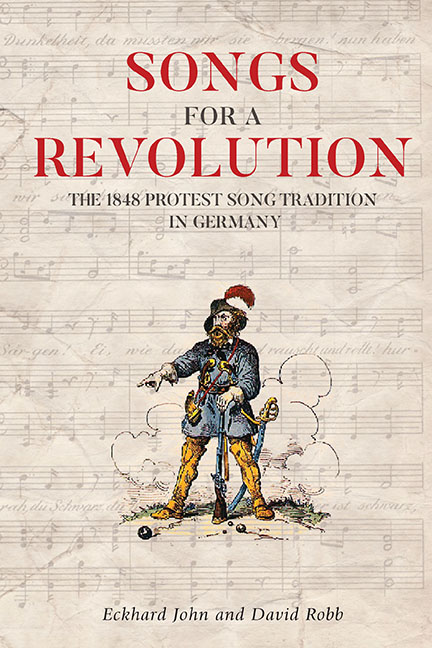Book contents
- Frontmatter
- Contents
- Preface
- Introduction: The Emergence of Political Song 1830–48
- Part I Before 1848: The Vormärz
- Part II 1848–49
- Part III 1848 in Memory
- Conclusion: The Making of Tradition; The Protest Songs of 1848 in the German Folk Revival 303
- Bibliography
- Discography
- Index of Names and Terms
- Index of Song Titles
5 - “Hier im Ort ist ein Gericht” (“Das Blutgericht”)
Published online by Cambridge University Press: 23 October 2020
- Frontmatter
- Contents
- Preface
- Introduction: The Emergence of Political Song 1830–48
- Part I Before 1848: The Vormärz
- Part II 1848–49
- Part III 1848 in Memory
- Conclusion: The Making of Tradition; The Protest Songs of 1848 in the German Folk Revival 303
- Bibliography
- Discography
- Index of Names and Terms
- Index of Song Titles
Summary
THE POLITICAL SONG “Hier im Ort ist ein Gericht” (In This Place There Is a Court) originated in the period directly prior to the weavers’ insurgency in Silesia, in which it played a prominent role as an expression of protest. The author of the song, which became known as “Das Blutgericht” (The Blood Court), remained anonymous. Musically it was a contrafactum of the ballad “Das Schloss in Österreich” (The Castle in Austria). An expression of misery and desperation, the song conveys the rage of the Silesian weavers at the factory owners and wholesalers, whom they deemed responsible for their social deprivation. Its inclusion in Gerhard Hauptmann's controversial play Die Weber (The Weavers, 1893) greatly increased the song's circulation—particularly in the song repertoires of the German workers’ movement up until 1933. This heritage was revived after 1945, first in the GDR, where “Das Blutgericht,” with its roots in the Vormärz period, was considered a model example of one of Germany's earliest revolutionary songs. From the late 1960s onwards it also increasingly struck a chord in the Federal Republic, where, in the context of the New Social Movements, the song's outcry against despotism and exploitation resonated as a symbol of the historical struggle against capitalist injustice. Particularly in the folk and Liedermacher scene of the 1970s “Das Blutgericht” enjoyed renewed dissemination and became one of the best-known revolutionary songs.
“Hier im Ort ist ein Gericht” originated presumably in the spring of 1844 as a protest against the local textile owners in the area of the Silesian factory village of Peterswaldau. Its author is unknown. Above all, it is said to have been sung by the younger generation of weavers from May 1844 onwards at their meetings on the Kapellenberg hill near Peterswaldau. The song circulated at that time in handwritten copies. In some instances these were even fastened to trees bearing the request that the song should be distributed further. The defamatory “Blutgericht” played a particularly key role during a demonstration in front of the villa of the Zwanziger firm in Peterswaldau on June 3, 1844, and as such contributed directly to the outbreak of the subsequent uprising.
- Type
- Chapter
- Information
- Songs for a RevolutionThe 1848 Protest Song Tradition in Germany, pp. 77 - 96Publisher: Boydell & BrewerPrint publication year: 2020



